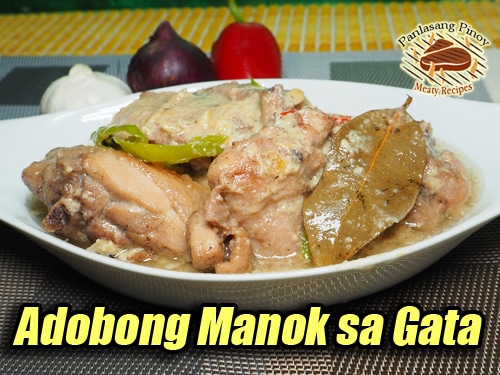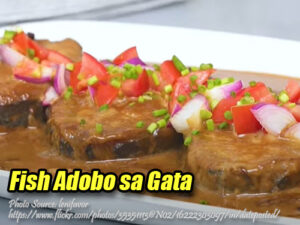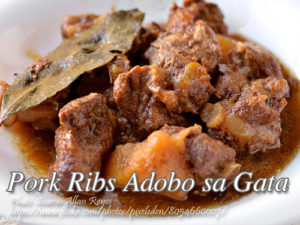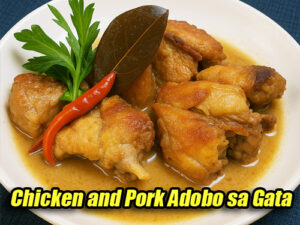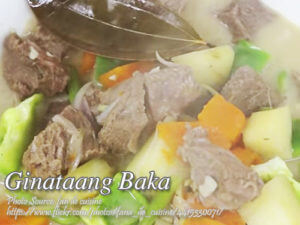Adobong manok sa gata is a very simple recipe and the only difference of this dish to the chicken adobo is it doesn’t contain soy sauce and added with coconut milk. In this chicken adobo dish, the soy sauce is substituted with patis or fish sauce. In most of the adobong manok sa gata recipes I’ve seen, soy sauce is still used as a flavoring.
I thought also at first that soy sauce is a must in cooking chicken adobo but when I tried substituting it with patis, I’m surprised that is taste better. I’m sure you will love it too! So what are you waiting for? Add this to your menu today!
Adobong Manok sa Gata: A Rich Flavor Family Tradition
There is much homeliness in cooking a dish that tastes much like home. To me, Adobong Manok sa Gata is more than a meal-it is a story. This version of chicken adobo has been the family heritage for generations. The coconut milk gives the dish rich, savory creaminess and changes the familiar tangy flavors to something comforting yet indulgent. While most recipes for chicken adobo rely on soy sauce for that salty depth, this version relies on fish sauce for the richness. This gives a lighter and more subtle flavor where coconut sweetness takes center stage.
My first exposure to this iteration was with my Tita Luz, whose origins are from Bicol-land, which boasts the dominance of coconut-flavored recipes. I recall going to her house as a small girl; heavy air was filled with the smell of sautéing coconut milk and garlic. “Soy sauce is not required every time,” she said while pouring spoonfuls of the simmering sauce on top of steaming hot rice. “Sometimes you just have to let the gata and patis speak for themselves.” And speak they did. This was one of those dishes that stays with you long after the meal is over, every bite a warm hug in your mouth.
Classic Twists: The Secret Ingredient Swap
Most adobo dishes rely on soy sauce as the base ingredient. It was as if one must put this into the recipe otherwise nothing else would ever suffice. Or so I thought until my Kuya Carlo made a suggestion to me – patis or fish sauce would work just fine. Of course, it was quite far fetched at first, but when mixed with the blend of garlic, bay leaves and freshly crushed black peppercorns into the chicken, then something magical occurred. The fish sauce mixed well with the flesh; it was salty, umami. Coconut milk smoothed everything on a velvety finish.
First, that one bite was revelation, yet it also showed familiarity with the traditional tang and depth of adobo but somehow unique creaminess that makes it feel completely new. I then realized that this dish lies on balance which does not only pertain to the flavors but also on using ingredients.
Cooking Up Nostalgia: Bringing Back the Taste of Bicol
No way to talk about this recipe without discussing its roots. The dish, of course, is from the Bicol region, justly famous for a love affair with coconut milk and spicy flavors. In typical Bicolano households, one easily finds gata used in so many dishes-from the rich laing to the fiery Bicol Express. An example of adaptation that Filipino cuisine does is using gata in this adobo.
My cousin Rina, who spent her summer vacations in Naga, remembers this dish fondly as her Lola Nena used to add siling labuyo for that extra kick of spice, a Bicolano signature. “Without the chilies, it just wouldn’t feel right,” she’d say as she tossed a few fresh red and green peppers into the pot. Heat from the peppers, and creaminess from the coconut milk set into a play of flavors that are bold but comforting at the same time. That is the fiery addition that gives this dish its own identity but still reminds one of the now-fabled adobo.
Why Coconut Milk?
One of the most often asked questions I get about cooking this dish is: why do I use coconut milk? The answer lies in the texture and flavor. Gata not only thickens the sauce but also adds a level of richness to every bite, making it silky and satisfyingly delightful. And while soy sauce adds that darker and saltier note to this dish, the fish sauce complements the natural sweetness of coconut without overpowering it.
Don’t worry that it will be too weak. The acidity from the vinegar is just what the sauce needs and provides a good complement to the rich creaminess. My versions often play a little game of tasting with a hint more fish sauce and vinegar until I hit that sweet harmony. I know I have when it clings to the spoon just so-not too thick, not too runny.
Serving Suggestions and Tips
This dish is best paired with a generous mound of steamed white rice since the subtle sweetness of the rice counteracts the richness of the sauce. Sometimes, I garnish it with a few fresh chilies and calamansi for a brighter fare. Of course, just like any stew or saucy dish, this one tastes even better the next day. Flavours develop more, and you’ll even look forward to leftovers.
A Recipe To Bring People Closer Together
This coconut-based adobo for me, coming from it as a recipe, would mean more of, among all the other things, how food can bring close each member of the family, and how a simple change in ingredients can start new traditions and memories. From the suggestion of my uncle to try fish sauce to my aunt’s insistence on using the freshest coconut milk, each step makes me recall the people and places that have shaped this dish.
Next time you feel like having something familiar yet exciting, try this adobo variant. Maybe it will become your new favorite too!
How to Cook Adobong Manok sa Gata
Ingredients
- 3/4 kilo chicken cut into serving pieces
- 6 cloves garlic chopped
- 3 Tbsp. patis
- 1 tsp. whole black peppercorns
- 1 tsp. sugar
- 1 cup coconut milk
- 1/2 cup vinegar
- 1/2 cup water
- 1/2 tsp. ground black pepper
- siling labuyo and long green chili pepper
- 2 Tbsp. cooking oil
Instructions
How to Cook Adobong Manok sa Gata
- Cut the chicken into serving pieces. Putin a mixing bowl and add patis and ground black pepper.
- Mix until the chicken is well coated with patis and pepper.
- Heat cooking oil in a pan and stir fry the chicken until brown. Move the chicken on the side of the pan and add the garlic.
- Stir the fry the garlic until brown. Then add vinegar, water, bay leaves, black peppercorns, patis and sugar.
- Cover then bring to boil and simmer in medium low heat for 15 to 20 minutes or until the chicken is tender.
- Add the coconut milk and bring to a boil. Simmer for 3 minutes or until the sauce is slightly thick.
- Add the siling labuyo and long green chilies and cook for half a minute then serve hot with cooked rice.
Video
Notes
Cooking Tips:
Use Fresh Coconut Milk for Better Flavor
Fresh coconut milk is always a better option compared to canned. Fresh gata will give you much creamier texture and a subtle bittersweet that will really draw out the savory flavor of the dish. If you can't find fresh coconut milk, high-grade canned coconut milk will do, though watch out for the preservatives in them, which might affect the taste.Balance Vinegar and Fish Sauce
Adobo is finding the balance between salty, tangy, and sweet flavors. Start with less fish sauce and vinegar and add more to taste. Keep in mind that the sauce will be thicker when it has reduced, so make sure to taste the mixture so it won't overpower the dish.Let Chicken Brown for Deeper Flavor
Let the chicken pieces be browned, then proceed to let them simmer in the sauce. This way, you will be able to add further richness to a dish with a more full-bodied depth and a crisp texture on the meat. Juices are also locked inside as the chicken cooks into the coconut sauce and comes out tender and flavored.
